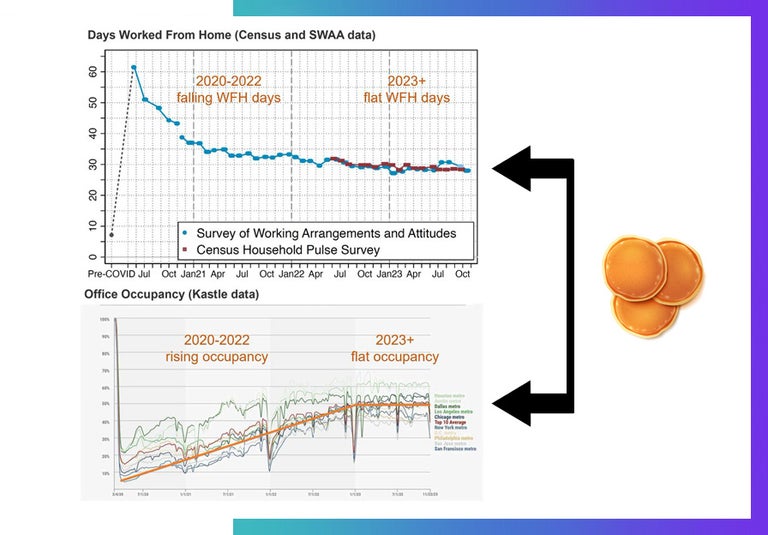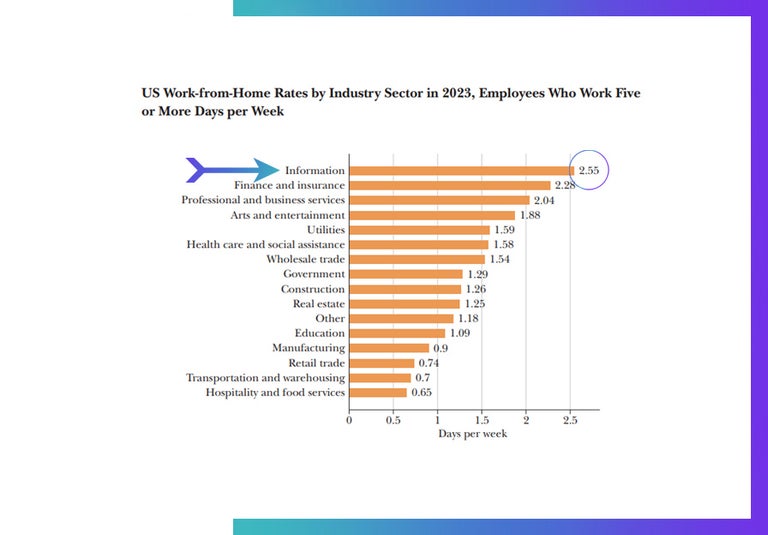Contents
- Key Insights and Remote Work Statistics for 2023
Who is Nick Bloom and what has he been saying this year? In this article we’re giving you a speedy wrap-up of his best insights on remote work, WFH and hybrid work.
Nicholas Bloom is Stanford University’s William D Eberle Professor of Economics.
He's most well-known for his research on working from home, which got him elected to the Bloomberg50. He also studies uncertainty and management practices in the workplace.
Nick is an important leader in the remote work movement, with a mission to advance the understanding and adoption of remote work in the world. If you follow insight on remote work, you've probably come across something he's said, researched or written.
His website WFHResearch is a trove of data and insight on – you guessed it! Working from home. In this article we’re outlining his key points, insights and predictions this year.
You can follow him here:
Key Insights and Remote Work Statistics for 2023
Here they are, a rundown of of the research and data insights Nick has been using to share the positive (and sometimes not so positive) aspects of remote work with the world.
A Freshly Published Paper
- Nick and co-authors José María Barrero and Steven J Davis published ‘The Evolution of Work from Home’ based on their latest findings. You can read the full paper in all of its glory here. Many of the insights in this article are from this paper.
Return to Office has Stalled (It’s Over)
- Nick published a post on X declaring ‘return to the office is dead,’ based on the latest Census, SWAA and Kastle data. In the post he shows a pancake effect, or a plateau happening - after the data shows falling WFH days throughout 2020-2022.
What does this mean? Quite simply it means that the big return to office has stopped. Rates are holding predictably steady, and a flat occupancy is evidence that WFH days are here to stay.

In the US Self-Employed, Contractors & Gig Workers Rule
Based on Nick’s surveys results, the people who are clearly working remotely the most are those of us who are self-employed, contracting or part of the gig economy.
- 48.3% are self-employed
- 44.4% are contractors or gig workers
Contrast this with regular employees who come in at a mediocre 11.8% (really large companies have the highest rate of fully remote workers too).

Tech Takes the Win for Most Remote Workers
- Based on Nick's research the information sector is working from home the most (2.6 days a week to be exact). Tech is still a driving force behind WFH.
- Coming in second and third are ‘finance and insurance’ with 2.28 days a week, and ‘professional and business services’ at 2.04 days a week.

Need to hire top talent in tech? We can help.
Some other key insights from the paper include:
- As population density rises, so does WFH prevalence.
- People in their 30s to early 40s work from home the most.
- Both men and women are working from home at similar rates.
- There is no real difference in productivity between hybrid and WFH.
- Fully remote productivity is determined by who is managing the team.
- The future? Here comes the Nike Swoosh – rising levels of remote work.
In 2023, the US work from home rate was 4X that of the US in 2019, before the pandemic.
That means a primed tech market ready to deliver remote work products and support because of massive growth. He expects that technology and rising productivity practices in remote work will fuel it’s climb over the next few years.
Fully Remote Workers are at Risk From AI
Nick Bloom recently weighed in on the risk that AI poses for people in data entry, call centers, HR and payroll styled jobs.
These are the jobs that are the least safe from AI, he says. They’re typically repetitive and because of that they could be replaced in 5-10 years.
WFH Goes Hybrid
Nick gives a vote of confidence for the hybrid model, which incorporates the WFH movement. He sees hybrid as an essential change in how we work, accommodating a wide variety of future disasters, climate issues, commuting delays, metro strikes or having the Olympics in town.
The flexibility of the model is what makes it so valuable.
Closing off the wrap-up of these 2023 insights, it’s clear remote work is thriving.
It’s become an integral part of the new way to work - with self-employed folks, contractors, and the tech sector leading the way. The proof is in the data!
With the stability of work-from-home trends, the rise of hybrid models, and the challenges posed by AI to certain jobs - we still have a long way to go until everyone who can work remotely, has the option.
One thing is certain, experts like Nick Bloom are important for a future where remote work is key to surviving in a world of uncertain change.
We can’t wait to see what the research says about our exciting landscape next year.






